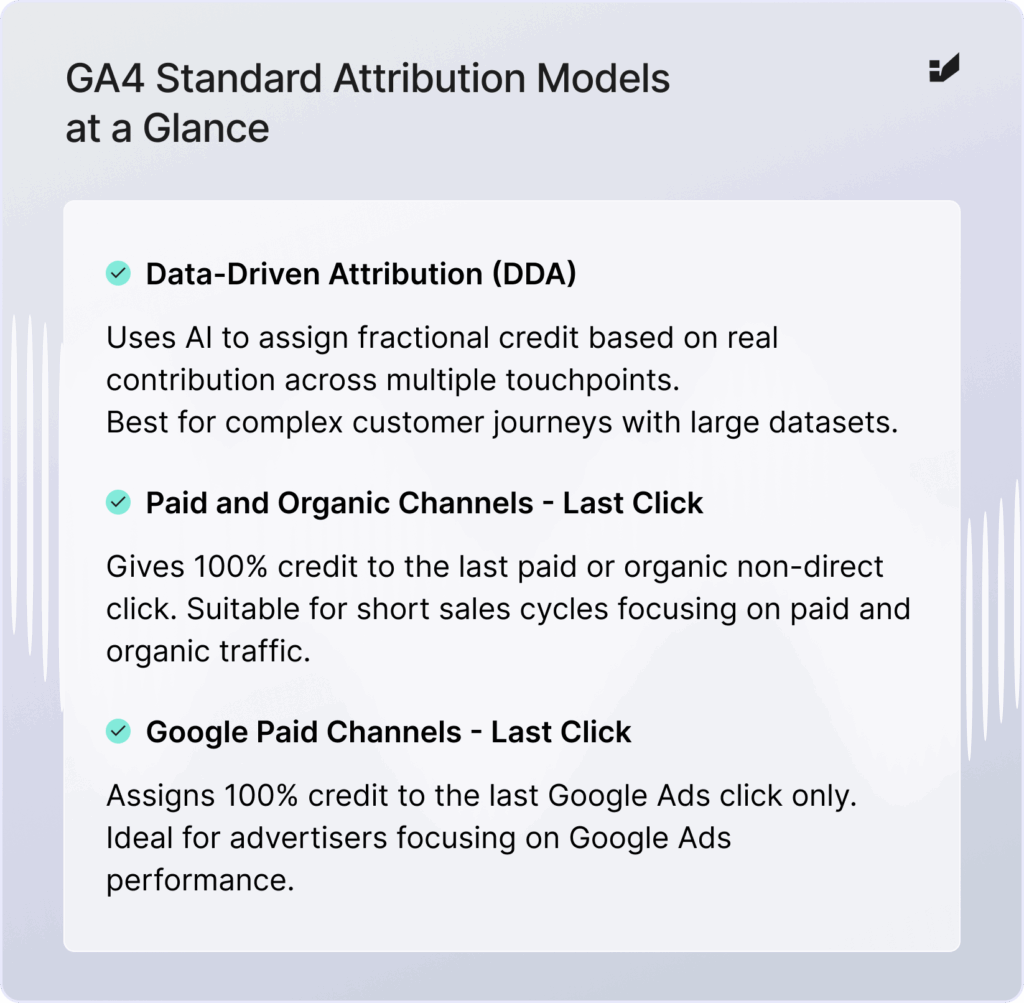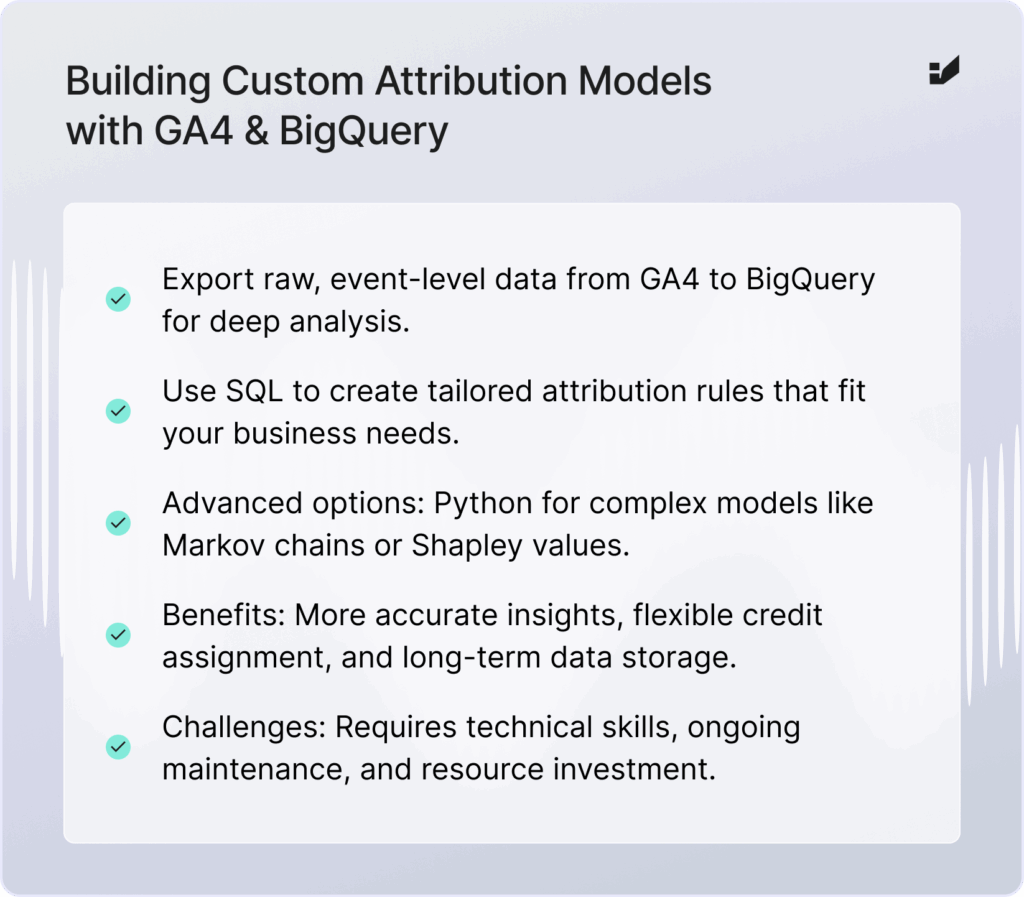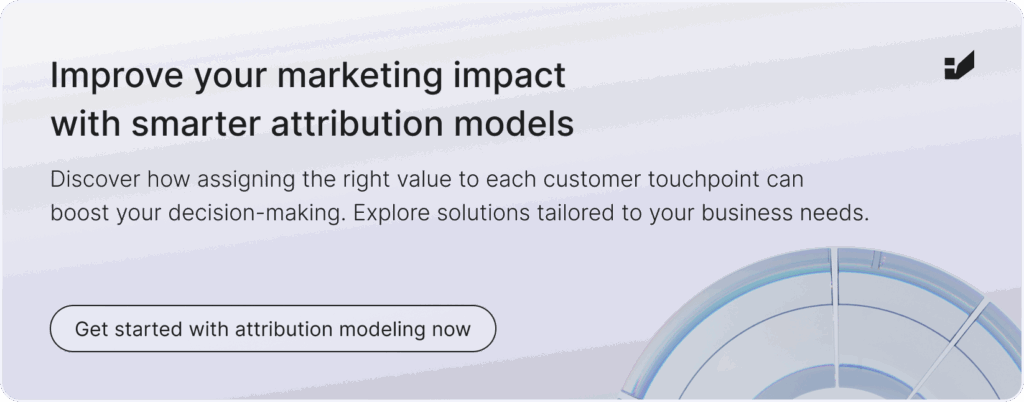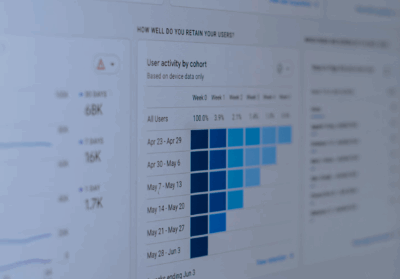GA4 Attribution Models and Custom Tracking Explained
Marketing attribution means giving credit for conversions to the right steps in a user’s journey. It helps you understand which activities drive results. This makes it easier to improve campaigns, set realistic goals, and spend your budget where it counts.
Without solid attribution, it’s easy to overestimate some channels and overlook others, leading to poor investments and missed opportunities. Google Analytics 4 is the new standard for web analytics. Unlike Universal Analytics, GA4 uses an event-based data model instead of sessions. This change affects how attribution is tracked and reported. GA4 comes with built-in models and supports custom setups, especially when connected to BigQuery. The event-based approach gives a more detailed view of how users interact across platforms and devices, which is now key to understanding performance.
Standard attribution models in GA4
GA4 offers three main attribution models. Choosing the right one affects how you interpret data and measure results.
Data-Driven Attribution (DDA)
This is the default model in GA4. It uses machine learning to analyze both converting and non-converting paths, assigning credit based on real contribution. It looks at things like time from interaction to conversion, device type, number of ad touches, and channel order. The result is a more accurate view of how conversions happen, beyond the limits of traditional rules.
Rule-Based Models
GA4 also includes two rule-based options:
- Paid and Organic Channels – Last Click gives all credit to the last non-direct click from paid or organic sources. Direct traffic is ignored unless it’s the only step in the path. This model works best for short sales cycles where the last interaction has the most weight.
- Google Paid Channels – Last Click gives full credit to the last click on a Google Ads campaign. If there’s no Google Ads click, it defaults to the Paid and Organic Channels – Last Click model. Again, direct traffic is only included if it’s the only touchpoint. This option is useful for advertisers who focus on Google Ads and want to track its specific impact.
The data-driven model is becoming more important in GA4 because it better reflects complex customer paths. However, it needs enough data for the machine learning to work properly. Also, the details of how the model works are not publicly available, as it’s proprietary to Google.

As of November 2023, several older rule-based models have been removed. These include First Click, Linear, Time Decay, and Position Based. Any reports using them were automatically moved to data-driven attribution. This change shows Google’s clear focus on machine learning as the go-to method for evaluating marketing impact in GA4.
Custom attribution solutions using BigQuery
Google BigQuery is a cloud-based data warehouse that integrates smoothly with GA4. GA4 offers a free, native connection to BigQuery, making it easy to export raw, event-level data. Within BigQuery, daily and intraday (real-time) tables are created. This setup gives you access to detailed, unsampled data and allows for long-term storage.
Once the data is in BigQuery, you can use SQL to query and transform it to build custom attribution models. There are also open-source SQL query collections specifically designed for GA4 analysis and attribution. More advanced users can take things further using Python to create complex, data-driven models like Markov chains or Shapley value-based models. BigQuery also gives you control over lookback windows, channel groupings, and conversion credit logic.

Building custom attribution models comes with clear advantages. You get more accurate results, can apply specific business rules, and gain deeper insight into customer journeys. On the flip side, it requires technical skills (especially in SQL and possibly Python), more computing resources, ongoing maintenance, and clearly defined attribution rules.
Table 1. Comparison of Standard Attribution Models in GA4
| Model Name | Description | Use Cases | Key Characteristics | Availability in GA4 (as of May 2025) |
| Data-Driven Attribution | Uses AI to distribute credit based on data, considering many factors. | Companies with large amounts of data and complex customer journeys, wanting the most accurate assessment. | Considers multiple touchpoints, assigns fractional credit, and dynamically adapts to data. | Available (default) |
| Paid and Organic Channels – Last Click | Assigns 100% of the conversion to the last click from paid or organic (non-direct) channels. | Companies wanting to track the effectiveness of both paid and organic marketing activities, and organizations with short sales cycles. | Ignores direct traffic if other interactions occur. | Available |
| Google Paid Channels – Last Click | Assigns 100% of the conversion to the last click on a Google Ads ad. | Companies that heavily using Google Ads and wanting to assess their direct impact. | Focuses solely on Google Ads, ignores other channels. | Available |
| First Click | Assigns 100% of the conversion value to the first interaction in the user’s path. | Companies focused on acquiring new customers and building brand awareness. | Highlights channels initiating contact, ignores later interactions. | Not available (retired in November 2023) |
| Linear | Distributes conversion value evenly across all touchpoints. | Companies that believe all interactions have an equal impact on conversion. | Easy to implement, does not account for the different weight of individual interactions. | Not available (retired in November 2023) |
| Position Based | Assigns 40% credit to the first and last interaction, and 20% is distributed among the middle interactions. | Companies that value both the first contact and the final interaction before conversion. | Combines elements of the first and last click model. | Not available (retired in November 2023) |
| Time Decay | Assigns more credit to interactions closer in time to the conversion. | Companies with long sales cycles where more recent interactions are considered more important. | Emphasizes the importance of recent interactions, reduces the impact of earlier ones. | Not available (retired in November 2023) |
Analysis of attribution reporting in GA4
Google BigQuery is a cloud-based data warehouse that integrates smoothly with GA4. GA4 offers a free, native connection to BigQuery, making it easy to export raw, event-level data. Within BigQuery, daily and intraday (real-time) tables are created. This setup gives you access to detailed, unsampled data and allows for long-term storage.
Once the data is in BigQuery, you can use SQL to query and transform it to build custom attribution models. There are also open-source SQL query collections specifically designed for GA4 analysis and attribution. More advanced users can take things further using Python to create complex, data-driven models like Markov chains or Shapley value-based models. BigQuery also gives you control over lookback windows, channel groupings, and conversion credit logic.
Building custom attribution models comes with clear advantages. You get more accurate results, can apply specific business rules, and gain deeper insight into customer journeys. On the flip side, it requires technical skills (especially in SQL and possibly Python), more computing resources, ongoing maintenance, and clearly defined attribution rules.
GA4 lets you choose and configure the attribution model used in your reports. You can find these settings in the “Attribution settings” section under the “Data display” menu in the Admin panel. The available models include: Data-driven attribution, Paid and Organic Channels – Last Click, and Google Paid Channels – Last Click. The model you select determines how conversion credit is distributed in your reports and analyses.
Another key setting is the lookback window for key events. This defines how far back in time GA4 will consider user interactions when assigning conversion credit. By default, the window is 90 days for most events and 30 days for first-visit conversions. You can adjust this window to match your sales cycle. Keep in mind that shorter windows may increase the number of conversions attributed to Direct traffic.
You can also control which channels are eligible to receive conversion credit. The options are “Paid and organic channels” or “Google paid channels” only. This gives you more control over how attribution is calculated and helps tailor your analysis to focus on what matters most for your business.
Latest changes and updates to attribution in GA4
Google has made several important updates to attribution in GA4. As mentioned earlier, models like First Click, Linear, Time Decay, and Position Based were retired in November 2023. The focus now is on the data-driven model and a limited set of rule-based options.
GA4 continues to improve in accuracy and consistency. New systems have been introduced to enhance data completeness and automatically detect reporting issues. Google has also added support for aggregated identifiers, which help better attribute conversions from paid Google Ads campaigns. If source and medium data are missing, a new value “(data not available)” now appears in those dimensions.
There are reports that more conversions are now being credited to Google Ads. This may reflect improvements in how paid traffic is tracked. If you’re running Google Ads, it’s a good idea to keep an eye on performance and budget allocation in light of these changes.
Limitations and key considerations in GA4 attribution
While GA4 attribution has improved, it still comes with limitations that marketers should keep in mind. One common issue is with “Direct” traffic. GA4 attributes conversions to Direct when no other source is found within the lookback window. This can skew your analysis if the actual source wasn’t tracked properly.
You might also see “(not set)” values in your reports. These can happen due to incorrect tracking setup, delays in data processing, or privacy settings on the user’s device.
Consent Mode and other privacy controls can reduce the amount of available attribution data. Tracking users across devices and browsers is another ongoing challenge, even with GA4’s user ID tools.
Another limitation is GA4’s data retention policy. By default, user-level data is kept for 2 months. You can extend this to 14 months in the free version, but that may still be too short for long-term analysis. For deeper insights, exporting data to BigQuery is recommended.
Also, keep an eye on channel groupings. Default groups can’t be edited, but you can create custom channel groups for more accurate reporting. Be aware that different GA4 reports may use different groupings by default — for example, the User Acquisition and Traffic Acquisition reports may show varying results.

What’s next for attribution in GA4
Attribution in GA4 will continue to evolve, shaped by AI, privacy regulations, and cross-platform tracking needs. Expect more features powered by artificial intelligence, like smarter forecasts, automated insights, and pattern detection.
Privacy-focused measurement will remain a priority. We’ll likely see further improvements in server-side tagging, consent management, and cookieless tracking. First-party data will become even more valuable.
GA4 may also introduce new options to better align attribution windows with your specific sales cycle. Deeper integration with Google Ads, and possibly other Google Workspace tools, is also on the horizon.
Data-driven attribution models will get more accurate as AI improves. At the same time, growing privacy restrictions may push GA4 to rely more on aggregated and modeled data rather than direct tracking. Marketers will need to adapt, and GA4 seems to be preparing for that shift.
Next steps for marketers
Attribution helps you understand what drives conversions. In GA4, you can choose between three models: data-driven, paid, and organic last click, or Google paid channels last click. Each has its pros and cons, but the data-driven model is the most accurate for most cases.
For companies with complex sales cycles or multiple touchpoints, building a custom model can be a better option. This can be done using GA4 data in BigQuery and Python. It allows for deeper insights and more control over how credit is assigned.
Choosing the right attribution model helps you make smarter decisions and improve your ROI. But attribution isn’t something you set and forget. Keep testing. Review how your model fits your goals and customer behavior. What worked a year ago might not work today.



